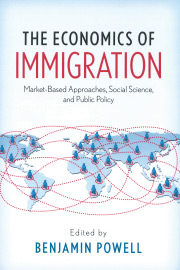Federal regulators are currently reviewing two major proposed telecom mergers. Verizon seeks to merge with MCI, and SBC wants approval to acquire AT&T. Critics claim these mergers would reduce competition and promote monopoly. In reality, these mergers are part of a healthy competitive process and would foster innovation and bring benefits to consumers.
Critics complain that these mergers will concentrate too much market share in land-line telephone communications among too few companies. One industry group has gone so far as to claim that the mergers, “will recreate the monopoly that existed before the government required AT&T to split up.” But any claim of market concentration or monopoly depends crucially on how you define the relevant market. Is the relevant telecommunications market the same today as it was 20 years ago when AT&T split up?
Two decades ago there were essentially two technologies for two-way communication: land-line telephone calls and what we refer to today as “snail mail.” Some could claim that when AT&T had all the land-line telephone business, they had a monopoly in instant two-way communication technology. Today the situation is much different. Twenty years of innovation has created new technologies that now compete with land-line service.
Cell phones are the most obvious alternative to land-line communication. In the United States there are now more wireless subscribers than land-line phone connections. Wireless calls account for about one-third of all local calls and three-fifths of long distance calls. Other forms of instant voice communication are also available. All major cable companies now offer Voice-over-Internet Protocol. The Internet explosion has brought instant messaging to millions of users. Many instant messengers, including AOL, offer voice communication for free. Even e-mail has become an alternative to land-line phone service.
The communications market today is nothing like what it was twenty years ago. Any definition of the relevant market must include these other forms of communication technology. Verizon, MCI, SBC, and AT&T don’t just face competition from other traditional phone companies. They face competition from companies like Comcast, Cox Cable, Microsoft, IBM, Intel, and America Online.
The communications industry innovates because it’s highly competitive. Consumers benefit because firms are free to introduce new products and offer new services. When some firms have competencies in areas where others don’t, they sometimes find it advantageous to merge to create synergies that lead to more integration and innovation. These combinations are part of the dynamic competitive process.
The Verizon and MCI merger is driven by competitive pressure. Sprint, Motorola, and Intel are working together to provide high-speed wireless communications and other firms are innovating as well. Verizon is a regional telephone service provider and a major competitor in wireless telecommunications. MCI is a long-distance carrier and a major provider of Internet backbone. Nobody can predict what innovations a merged Verizon-MCI will create, but the increasing integration of communications has made the potential synergies between these companies obvious.
The main opponents of the telecom mergers, of course, are their competitors. Qwest Communications, which failed in an earlier attempt to acquire MCI, has petitioned the Federal Communications Commission against the mergers. In addition, a group of smaller communications companies—who ironically call themselves the Alliance for Competition in Telecommunications—also opposes the mergers. Both groups claim they want the government to block the mergers to preserve “competition”—but they are really asking the government to limit the ability of Verizon-MCI and SBC-AT&T to compete by taking away their ability to merge. Protecting these inefficient competitors is not the same thing as protecting competition.
Competition is not a static state of affairs where market share determines whether an industry is “competitive.” Competition is a dynamic process where firms discover new ways to innovate and to compete for customers. Businesses merging in order to gain new competencies are a vital part of the competitive process. Consumers will benefit if we preserve the competitive process by allowing these two telecom mergers to proceed.











